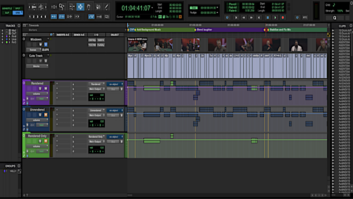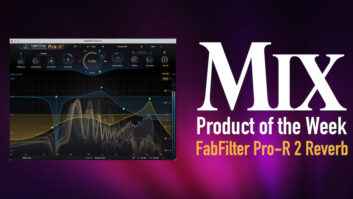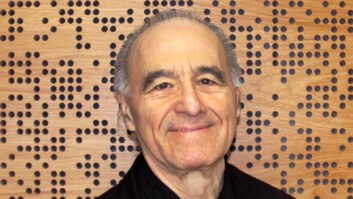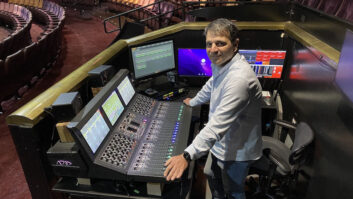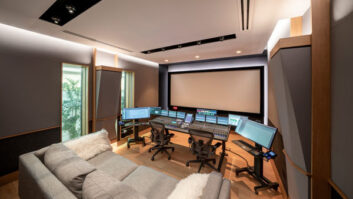A mild hypnotic suggestion: The next time a ringwraith, explosion, tidal wave, symphony or laser beam leaps off of the screen and takes a lap around your home theater, think about which of the following multichannel effects the production team used; rest assured, at least one processor will have been employed per scene. This guide represents the maturation of a new subcategory of surround audio products that are very much in demand these days. Who knows, by next year, the term “stereo plug-in” may actually start showing up in articles — oh, how retro!
Mix queried software and hardware developers to put the following surround processor descriptions together. Press day being a week before this year’s Winter NAMM, and current trends considered, this grouping of surround processors is likely to grow considerably by the time Mix‘s 2004 surround effects guide goes to press. Multichannel effects, dynamics, reverb and mastering units are included this time around, but surround encoding, panning, routing, joystick, speaker control, bass management or 3-D audio-processing offerings are not; similarly, new surround plug-ins added to some DAW programs are mentioned, but similar surround features built into many professional digital consoles and workstations are not.
Audio Ease‘s (www.audioease.com) Altiverb for Mac G4 is a native sampled-acoustics plug-in for MAS, HTDM, RTAS and VST systems. Altiverb offers 1, 2 and 4-channel sampled acoustics of spaces such as concert halls, cathedrals, even bathrooms and closets; dozens of acoustic samples are included, and users can also sample their own environments. The interface displays a photo of the actual room a preset is based on, and comes with software to create JPEG pictures of user-sampled acoustic spaces. Taking full advantage of the G4 Altivec Velocity Engine co-processor, Altiverb works in real time, producing up to 40 seconds of reverb decay.
New from Cube-Tec (www.cube-tec.com) is a slew of surround mastering and restoration Virtual Precision Instrument (VPI) options for the company’s AudioCube 5 DAW platform. The SurroundCube suite includes seven surround-specific VPIs ($3,750/each), five of which are effects processors, and all moving audio at up to 24-bit and 384kHz resolution. Magneto Eight is an 8-channel surround version of the company’s stereo Magneto processor, which emulates tape compression and saturation effects in 15 and 30 ips modes, and can be linked and grouped on all eight channels, as well as to the other surround VPIs. Loudness Maximizer Eight allows users to build separate linkable groups to control front and surround speakers, while maintaining separate LFE control with other speakers. Its unique unity gain structure through the VPI promises to facilitate parameter settings for increased transparency.
Another 8-channel version of an existing Cube-Tec stereo processor is EQ Eight, a new surround version of its Analog EQ. Four fully parametric bands plus variable high and low shelving, selectable slope and high- and low-cut options per channel provide plenty to play with, but users may opt instead to start with EQ Eight’s presets, modeled on the characteristics of the world’s top mastering equalizers. Rounding out the company’s new surround plug-in offerings is Compression Eight, a new 8-channel VPI and plug-in that allows the compressor’s response to be frequency-sensitive and to apply identical settings to linked channels. The latter feature ensures that when the gain of one or more channels exceeds threshold, the signal of all linked channels will be identically compressed.
Drawmer (www.drawmer.com; www.transaudiogroup.com) was the first in 2002 to release a dedicated hardware multidynamics surround six-pack, named, coincidentally, Six-Pack ($2,575). Each of the six independent modules in this three-rackspace, brushed-aluminum gem is clearly indicated and metered for the expander/gate, compressor and peak/limiter functions provided by each module. Six-Pack’s six independent expander/gates, auto and manual compressors, “zero overshoot” limiters and the ability to link channels individually make it ideal for surround and live outboard applications, such as drum processing. Six-Pack can be reconfigured to provide dynamic control and surround-speaker protection without image shift during live surround applications. Each Six-Pack module is based on the company’s popular Drawmer DL241 Compressor.
Eventide (www.eventide.com) expects its two new 8-channel surround I/O expansion cards for the flagship Orville effects processing platform (ADAT I/O $395, $695 AES/EBU I/O; $995 both, includes factory installation) to ship by the time this article prints. In addition to adding several new surround effects processing algorithms to Orville, Eventide now provides these new hardware upgrades for Orville and the Orville/R “blank-panel” version that utilizes the EVE/NET remote control. Users can now process all eight channels of digital I/O or select inputs and outputs in pairs and route those to and from any desired Orville DSP engine. The AES/EBU expansion option replaces Orville’s analog I/O to provide eight channels of balanced digital audio with up to 24-bit/96kHz resolution and the ability to high-sample-rate convert without having to convert to analog and back again. Orville’s Version 3.0 software debuted at Winter NAMM, as well. Stay tuned.
Kurzweil (www.kurzweilmusicsystems.com) offers the KSP8 mega multi-effects processor ($2,995) and its companion RSP8 remote controller ($595). Billed as a high-end 8-channel multibus signal processor with great real-time control, the KSP8 doubles the K2600 KDFX’s processing power and adds a number of new algorithms, including surround reverbs and additional stereo and mono algorithms. Up to eight channels of audio can be processed simultaneously in mono, stereo and surround combos, each sharing one of 16 available processing units on up to eight effects buses. Users can customize effect presets and signal chains for up to 999 object locations and store them to SmartMedia cards, each holding a “studio” snapshot of physical connections, analog and digital I/O routing and levels, effects chains, bus assignments and more per program. Also impressive is the fact that the KSP8 offers 249 DSP algorithms including reverbs, choruses, delays, distortions, EQs, cabinet simulators and compressors, as well as 5.1 surround audio algorithms with multichannel compression. I/O options include analog, AES/EBU, S/PDIF, Lightpipe, TDIF and wordclock connections.
Lexicon (www.lexicon.com) has added both exterior and interior improvements to its surround sound powerhouse, the 960L Multi-Channel Digital Effects Processor (starting at $11,500). The LARC2, the 960L’s remote user interface, has been totally redesigned and now includes eight touch-sensitive, motorized, auto-nulling faders, along with the company’s new Automation Package and the LOGIC7 Upmix Algorithm Package, which are now standard equipment with the 960L. The Automation Package enables multichannel functions such as surround algorithms (based on Lexicon’s DPM Algorithms: 3-Dimensional Perceptual Modeling), parameter adjustments, wordclock settings, DSP configuration and I/O settings to be fully recallable.
Built-in now to the Pyramix software DAW platform is the new MPEX2 Surround Sound Time Compression/Expansion and Pitch Scaling plug-in from Merging Technologies (www.merging.com). Developed by German-based Prosoniq for Merging, MPEX2 offers multichannel time compression and expansion control in percentage ratios, bpm and timecode-in/out positions. Full pitch and formant control can be processed in parallel while maintaining time and phase alignment over all tracks for 5.1 and 7.1 surround formats. A 24 fps-to-25 fps function (and vice versa) has also been included with MPEX2 to provide straightforward resynchronization of surround master mixes for film.
MOTU (www.motu.com) last year added some more surround tools to Digital Performer’s list of built-in MAS plug-ins, including MasterWorks Limiter Surround Edition, Parametric EQ Surround Edition and Feedback Delay Surround Edition. The latter is a surround delay plug-in that provides detailed control over every channel in a mix by graphically constructing the “flight paths” of up to 100 discrete delay feedback signals. Don’t worry: A panic button mutes delays if and when an audio experiment gets out of hand. Parametric EQ Surround Edition, as its name implies, provides n channels of parametric EQ for surround mastering; specifically designed for mastering surround mixes is the MasterWorks Limiter Surround Edition plug-in. Completely independent LFE limiting and assignable detector paths allow users to feed any combination of n-speaker channels to the limiter-detector path; for example, feeding a center channel to the detector path to duck an entire surround mix during a dialog passage.
Sony‘s (www.sonyproaudio.com) DRE-S777 is a 4-channel “sampling” reverb, meaning that it can sample and re-create the natural reverberation characteristics of any acoustic space (or processing unit). This reverb “signature” can then be added to any audio, with control over reverb time and pre-delay. The DRE-S777 supports a range of sampling frequencies up to 24-bit/96 kHz, and has full surround sound capabilities; in addition, several units can be linked to provide a realistic 3-D surround field. A built-in 4-band EQ and simple mixer allow full control of direct and effect signals. The DRE-S777 comes with samples of halls, churches, studios and effects; CD-ROM library sets featuring acoustic spaces from around the world are available. Users can also sample their own spaces with optional software.
On the software side, Sony’s new Oxford Dynamics plug-in is a compressor/dynamics processor for Pro Tools, modeled on the processor used in the OXF-R3 console. Applications include separate compress, limit, expand, gate and sidechain EQ, with full independent control of all parameters; a full surround, multiformat-compatible bus compressor/limiter is included. The Oxford Dynamics plug-in is slated to for a spring release, at a suggested list price of $850.
Initially announced in 2001, Steinberg‘s (www.steinberg.net) Nuendo Surround Edition plug-in suite ($1,299) began shipping toward the beginning of last year with four surround plug-in offerings built by the folks at Spectral Designs. OctoVerb is a “true-surround” 8-channel room-simulation tool with improved surround-specific reverb algorithms and an intuitive graphic predelay and reverb-shaping interface. The 8-channel, single-band OctoComp can continuously blend RMS and peak characteristics. The Nuendo Surround Edition suite, which now supports full automation recall of every parameter, also includes OctoQ (an easy-to-use, high-quality, 7-band surround equalizer that creates digital EQ models as IIR filters) and OctoMaxx, a multichannel version of Steinberg’s popular Loudness Maximizer stereo plug-in.
The System 6000 is TC Electronic‘s (www.system6000.com) flagship signal processor, offering a variety of effects such as multichannel reverb and multiband dynamics processing. Multichannel pitch change processing is available, as well as classic TC reverb, chorus, delay, phaser and EQ algorithms; sample rates up to 96 kHz are supported. More than 600 presets are available, including the new Halls of Fame bank, offering settings contributed by top engineers like Chris Boyes, George Massenburg, Al Schmitt and more. The Halls of Fame bank also includes the first part of The Skywalker Sound Collection of first Reverb and Room Simulation presets. The System 6000’s Icon remote, featuring a touchscreen and touch-sensitive faders, integrates with the a single-rackspace device called the CPU 6000, which acts as a communication device, running in tandem with the Mainframe 6000s that power the system.
Also available from TC is the Reverb 6000, offering multi-format delay and boundary effects; 300 presets, including settings from film and music pros; a 6-channel room simulator; and more, including a back catalog of TC classics at their highest resolution, from M5000 and M3000 to the System 6000. The Reverb 6000 can accommodate two 6.1 reverbs or 16 mono, and any format can be used simultaneously. System 6000 algorithms can be added to the Reverb 6000 toolset.
The TC Surround Verb ($699, Mac/PC; dist. by Steinberg) from TC Works (www.tcworks.de) provides Nuendo users with a native, “TC-quality” 5.1 surround reverb. TC Surround Verb’s easy-to-use interface includes graphic displays of reverb components and control over all key components required for reverb design, including room shape, size, diffusion, early reflections and reverb tails. The reverb tail supplies three independent bands for low, mid and high-frequency control with sweepable-band crossovers and an additional EQ stage with low- and high-shelf filters.
Universal Audio (www.uadio.com) announced full Pro Tools|HD support for its previously released RealVerb 5.1 plug-in (and SmartCode Surround Pro and SmartPan Surround Pro plug-ins, as well). The first multichannel reverb plug-in for Pro Tools when it first shipped, RealVerb offers sophisticated algorithms to model physical spaces and extensive shapes and materials to affect environments; preset morphing and the ability to independently place the direct path, early reflections and late-field reverb in the soundfield further add to this surround toolbelt. Features include source distance-perception adjustment and control over individual output channels to simplify the process of creating alternative mixes (4.0, L-C-R, etc.). Also from UA was news that the company began releasing TDM versions of its Powered Plug-Ins, including the 1176LN, LA-2A and Pultec EQ; upgrades to versions of the plug-ins sold previously under the Kind of Loud name now support TDM under the Universal Audio brand name. All UA TDM plug-ins will support Pro Tools|HD and Mac OS.
Next up from Waves (www.waves.com) is the 360° Surround Tools TDM ($2,400), a complete surround mixing, reverb, dynamics and management tools bundle released exclusively on DSP for Pro Tools|HD and MIX Macintosh systems at AES in October. Supporting 96k and 192k for all Digidesign MIX and Pro Tools|HD users, the Surround Toolkit comes with seven surround plug-ins, including: Surround Imager to add distance panning, early reflections and shuffling for improved low-frequency spatialization; Surround Reverb to control over six channels of de-correlated reverberation and special front and rear-channel surround signals; and Surround Compressor, with channel coupling and link for all surround channels or as three separate groups.
Randy Alberts is a Bay Area freelance writer.
